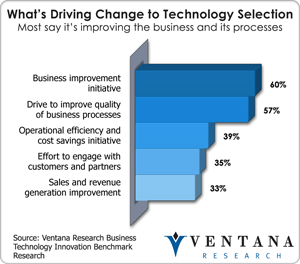Data is a commodity in business. To become useful information, data must be put into a specific business context. Without information, today’s businesses can’t function. Without the right information, available to the right people at the right time, an organization cannot make the right decisions nor take the right actions, nor compete effectively and prosper. Information must be crafted and made available to employees, customers, suppliers, partners and consumers in the forms they want it at the moments they must have it.
Data is a commodity in business. To become useful information, data must be put into a specific business context. Without information, today’s businesses can’t function. Without the right information, available to the right people at the right time, an organization cannot make the right decisions nor take the right actions, nor compete effectively and prosper. Information must be crafted and made available to employees, customers, suppliers, partners and consumers in the forms they want it at the moments they must have it. Optimizing information in this manner is essential to business success. Yet I see organizations today focusing on investments in big data because they believe it can effortlessly bring analysts insights. That premise is incorrect.
Organizations must do everything they can to ensure that they can turn content and data into information. Just loading data into a new technology – in this case big data – won’t do the trick. The process requires people who know how to get the right data and put it into the right forms, and is more art than science. Indeed, the challenge becomes more difficult as economic and competitive pressures make it harder to enlist qualified data scientists. Accommodating to this situation – being able to act faster and smarter while relying on fewer human assets – requires properly configured, easy and immediate access to the information needed to address a business need.
The typical model in organizations – a request to an analyst team for answers, copying and pasting from existing reports and spreadsheets into a single document, or maybe a request to the IT organization for reports or changes to how data is presented, then gathering other documents and information about the situation on the Internet or internally – is far too slow, and in fact our technology innovation research shows that 44 percent of organizations identify data-related tasks as barriers to spending more time on analytic ones. Organizations need their information to be available to anyone authorized on demand, in the form needed and through the channel requested, regardless of how or where it is stored. Not being able to deliver the right information impacts the quality of decisions made and actions taken and weakens the business processes on which teams and individuals rely. Data continues to be spread across too many applications and systems, as our information management research found in 67 percent of organizations. Continuing down this path is a waste of time and resources and impedes analysts and business in their work to assess and guide optimized efforts.
organization for reports or changes to how data is presented, then gathering other documents and information about the situation on the Internet or internally – is far too slow, and in fact our technology innovation research shows that 44 percent of organizations identify data-related tasks as barriers to spending more time on analytic ones. Organizations need their information to be available to anyone authorized on demand, in the form needed and through the channel requested, regardless of how or where it is stored. Not being able to deliver the right information impacts the quality of decisions made and actions taken and weakens the business processes on which teams and individuals rely. Data continues to be spread across too many applications and systems, as our information management research found in 67 percent of organizations. Continuing down this path is a waste of time and resources and impedes analysts and business in their work to assess and guide optimized efforts.
This challenge has increased interest in new information optimization technology, which we plan to study as part of our research agenda on big data and information management. Such technology can collect data in any format, assemble and integrate it as needed and enable individuals to access and work with it as information in the desired forms. The data can take any of a wide array of forms, structured or not, and may originate in a report or a document or be stored in any of a variety of business intelligence tools, applications and database systems. Information optimization technology can access that data and present it dynamically in ways simple and flexible enough for anyone to use it without training or assistance from others.
Under the hood, though, careful planning is required to satisfy the broad range of information demands both inside and outside of the enterprise. Organizations must find, evaluate and put in place the technology and platforms to assemble and present the information. This is not just a data integration challenge that might help with moving structured data across information systems, but rather a broader undertaking to empower business with the ability to capture information from many systems and sources.
An information optimization platform must be able to handle the volume of information requests from groups and individuals based on all the data residing inside and outside the organization. Moreover, as these are certain to increase, it must offer scalability and the potential to meet users’ increasing performance needs. To satisfy the many types of users and skill levels, it must rank high for usability, offer flexibility in user interfaces and be accessible from many applications, portals and mobile devices. In short, the platform must become an effective foundation element of the organization’s information architecture and support a range of needs that can span from capturing data, modeling and converting it while maintaining security, automating the process and sharing and distributing information.
Understanding the need for and choosing technology to support information optimization is not easy. Information optimization is a new focus in the enterprise software market, a new segment that builds on existing investments in business intelligence, reports, business applications, content and document management, information systems and information management, and benefits from recent advances in business analytics and big data to lift them to a higher level of value and use. Building on our past research on information applications and information management we are examining what is necessary for organizations to deliver unified information faster and better than ever before.
 Today, many organizations lack the skills, process and technology to optimize the use of information. Our technology innovation research found that more than half of organizations (51%) say that not having enough skilled resources is the major barrier to advancing their competencies to use new and innovative technology. Traditional IT architectures have not advanced to meet the business needs for information optimization solutions today, and since information optimization is not easy, organizations are facing challenges in identifying the right types of integration technologies, adapting them to their particular needs and assembling information for business use.
Today, many organizations lack the skills, process and technology to optimize the use of information. Our technology innovation research found that more than half of organizations (51%) say that not having enough skilled resources is the major barrier to advancing their competencies to use new and innovative technology. Traditional IT architectures have not advanced to meet the business needs for information optimization solutions today, and since information optimization is not easy, organizations are facing challenges in identifying the right types of integration technologies, adapting them to their particular needs and assembling information for business use.
The advent of big data technologies such as Hadoop provides new and rich repositories that can be exploited if technology is designed to access them. Organizations can choose from a vast array of new big-data-oriented technologies, including Hadoop, in-memory databases, data appliances and RDBMSes. In addition accessing information from across the Internet including information on customers or feeds from distributors and suppliers that could be specific sources to an organizations industry or even online systems and applications operating in cloud computing environments are essential. They must apply the right level of security to ensure that data is protected and made available only to those authorized to see it . All this must happen with information that is not static but proceeds along a workflow and must be available when people need to collaborate. Also, information should be optimized to make it accessible from mobile technology and easily found via search technology.
Organizations are taking dramatically different approaches to optimizing the use of information to make it available on demand from any source at any time. Designing more effective information processes is critical to improving the maturity of organizations with regard to information optimization and the use of the rich content, data, documents and reports, which are key elements of enterprise use of information. Considering the benefits of using technology to enable information optimization and taking advantage of big data and existing investments is critical, and our technology innovation research finds that business improvement initiatives are leading the way in 60 percent of organizations.
the use of information to make it available on demand from any source at any time. Designing more effective information processes is critical to improving the maturity of organizations with regard to information optimization and the use of the rich content, data, documents and reports, which are key elements of enterprise use of information. Considering the benefits of using technology to enable information optimization and taking advantage of big data and existing investments is critical, and our technology innovation research finds that business improvement initiatives are leading the way in 60 percent of organizations.
We have announced new research as part of our direct investigation on information optimization that will search out and document emerging best practices in information optimization from early adopters, and will determine the extent to which companies have adopted or plan to implement them. We will investigate the IT infrastructures and information-related needs of organizations’ business areas to help establish the real value and business case for investment in information optimization.







